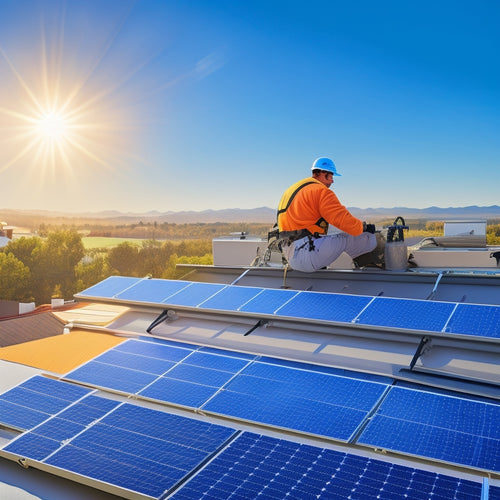
Connecting Solar Panels to a Battery in 5 Steps
Share
You're ready to connect your solar panels to a battery in 5 steps. First, prepare your solar panel system by verifying its condition, conducting routine maintenance, and ensuring electrical connections are secure. Next, choose the right battery type based on capacity, voltage, and chemistry, and select a compatible charge controller. Then, connect your solar panels together in parallel, using suitable wiring and secure connections. After that, link the battery to the system, following wiring safety guidelines and manufacturer's instructions. By following these steps, you'll unleash the full potential of your solar panel system, and explore even more ways to optimize your energy output.
Key Takeaways
- Verify the solar panel system's condition and perform routine maintenance to maximize energy efficiency before connecting to the battery.
- Choose the right battery type based on capacity, voltage, and chemistry, ensuring compatibility with the solar panel system's voltage and capacity.
- Select a suitable charge controller that regulates energy flow between solar panels and the battery, considering efficiency, cost, and compatibility.
- Connect solar panels in parallel to maximize power output, using suitable wiring and securing connections with wire connectors and terminal screws.
- Link the battery to the system, following wiring safety guidelines and manufacturer's instructions for safe and efficient connections.
Prepare the Solar Panel System
Pick up your solar panel system and let's get started. Before connecting it to a battery, verify it's in prime condition. Conduct routine solar panel maintenance to maximize energy efficiency.
Inspect the panels for dirt, debris, or damage, and clean them accordingly. Confirm the system's electrical connections are secure and corrosion-free. Check the panel's technical specifications to verify it's compatible with the battery you'll be using.
Next, perform a system diagnosis to identify any issues. Analyze the panel's energy output to detect potential faults. Use a multimeter to measure the voltage and current output, and compare it to the manufacturer's specifications.
Identify and repair or replace any faulty components to guarantee peak energy efficiency.
Choose the Right Battery Type
As you prepare to connect your solar panel system to a battery, selecting the right battery type is essential to guarantee efficient energy storage and ideal system performance.
You'll need to take into account factors like capacity, voltage, and chemistry to ascertain your battery meets your energy demands.
Lithium-ion batteries are a popular choice for solar energy storage due to their high energy density, long lifespan, and low maintenance requirements.
They offer several advantages, including high discharge rates, low self-discharge, and a long cycle life. Additionally, lithium-ion batteries are relatively lightweight and compact, making them perfect for residential and commercial applications.
When choosing a battery type, reflect on your specific energy needs and the overall system design.
You'll want to make sure your battery is compatible with your solar panel system's voltage and capacity.
Proper battery maintenance is also important to extend the lifespan of your battery. This includes monitoring temperature, state of charge, and voltage to prevent overheating, overcharging, or deep discharging.
Select the Correct Charge Controller
A solar panel system's charge controller plays an essential role in guaranteeing efficient energy transfer between your solar panels and battery. It regulates the flow of energy, preventing overcharging or undercharging, which can damage your battery or solar panels.
You must select the correct charge controller for your system to guarantee peak performance.
There are several charge controller types to choose from, including Pulse Width Modulation (PWM) and Maximum Power Point Tracking (MPPT). MPPT controllers are more efficient, especially in partial shading conditions, but are also more expensive.
PWM controllers are simpler and cost-effective, but may not perform as well in certain conditions.
When selecting a charge controller, consider the voltage and current ratings, as well as the compatibility with your solar panel and battery systems.
Follow the installation guidelines carefully, confirming the controller is installed in a well-ventilated area, away from moisture and extreme temperatures. Proper installation will confirm your system operates safely and efficiently.
Connect the Solar Panels Together
Now that you've selected and installed a suitable charge controller, you're ready to connect your solar panels together. This step is essential to utilize the maximum power from your solar panel array.
Begin by connecting the solar panels in parallel connections, ensuring each panel's positive terminal is connected to the positive terminal of another panel. This configuration allows the panels to share the load, increasing the overall power output.
When connecting the panels, use suitable solar panel wiring that can handle the maximum current output of your panel array. Make sure the wiring is rated for DC power and is resistant to UV radiation and extreme temperatures.
Use wire connectors and terminal screws to secure the connections, ensuring they're watertight and protected from the elements. Verify the connections are secure and correct, then proceed to the next step.
Link the Battery to the System
With your solar panel array connected and ready, you're one step away from utilizing the power it generates - linking the battery to the system. This critical step requires careful planning and execution to guarantee safe and efficient energy storage.
First, determine the ideal battery placement, considering factors like ventilation, temperature, and accessibility. Verify the battery is installed in a well-ventilated area, away from flammable materials and heat sources.
Next, prepare the wiring, selecting cables that meet the system's voltage and current ratings. Always follow wiring safety guidelines, using appropriate connectors and securing cables to prevent damage or electrical shock.
Connect the positive terminal of the solar panel array to the positive terminal of the charge controller, and the negative terminal to the negative terminal. Then, link the charge controller to the battery, following the manufacturer's instructions.
Frequently Asked Questions
Can I Use a Car Battery for My Solar Panel System?
You're wondering if a car battery will cut it for your solar panel system, but here's the thing: car batteries aren't designed for deep-cycle use, limiting their solar battery compatibility, and they'll likely degrade quickly, so it's not the best choice.
How Often Should I Check the Charge Controller's Settings?
You should regularly check your charge controller's settings to confirm ideal performance, adjusting them as needed to prevent overcharging or undercharging, and perform routine charge controller maintenance to assure your system operates at peak efficiency.
What Happens if I Oversize My Solar Panel System?
If you oversize your solar panel system, you'll reduce solar efficiency and potentially shorten your battery's lifespan, as excess energy is wasted as heat, and deep discharge cycles increase, affecting overall system performance and reliability.
Can I Connect Multiple Solar Panel Systems Together?
You're wondering if you can amplify your solar power by connecting multiple systems together? Yes, you can! By designing compatible solar panel configurations, you'll safely utilize more energy through series connections, exponentially enhancing your power potential.
Do I Need a Backup Generator for My Solar Panel System?
You'll likely need a backup generator if you rely heavily on your solar panel system, especially during periods of low solar panel efficiency, to guarantee uninterrupted power; consider exploring backup power options to secure energy consistency.
Related Posts
-

Why Certification Matters for Residential Panels
You're looking to understand why certification matters for residential panels. Basically, third-party certification g...
-

Top 10 DIY Conversion Kit Reviews and Tips
You're taking the first step towards electrifying your ride, and with the right DIY conversion kit, you'll be cruisin...
-

3 Essential Steps for Solar Electricity Installation
To guarantee a successful solar electricity installation, you'll need to follow three essential steps. First, assess ...


